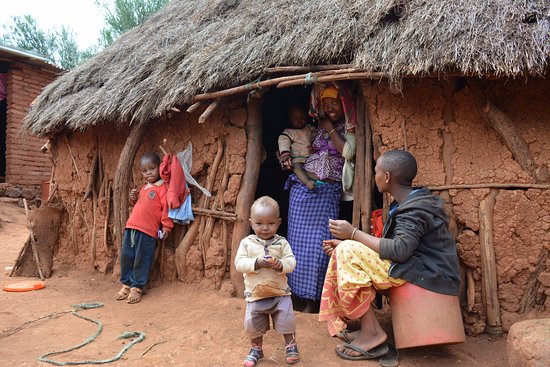Iraqw people
The Iraqw, are a Cushitic-speaking ethnic group inhabiting the Great Lakes region of East Africa. They live in the Arusha and Manyara regions of north-central Tanzania, near the Rift Valley wall and south of Ngorongoro Crater.
History
Kerio Valley
The Iraqw have traditionally been viewed as remnants of Afro-Asiatic peoples who practiced agriculture and animal husbandry in the Great Lakes region a succession of societies collectively known as the Stone Bowl cultural complex. Most of these early northern migrants are believed to have been absorbed by later movements of Nilotic and Bantu peoples. In the Kerio Valley of Kenya, among other neighboring areas, there are vestiges of the Neolithic tillers’ civilization in the form of elaborate irrigation systems. Although these particular structures are today maintained by the Marakwet subgroup of the Nandi Kalenjin Nilotes, the latter aver that they were the work of a northern people of peculiar language called the Sirikwa, who were later decimated by pestilence. According to the Marakwet, the Sirikwa “built the furrows, but they did not teach us how to build them; we only know how to keep them as they are.”
Engaruka
Additionally, the Iraqw’s ancestors are often credited with having constructed the sprawling Engaruka complex in northern Tanzania. The modern Iraqw practice an intensive form of self-contained agriculture that bears a remarkable similarity to the ruins of stone-walled canals, dams and furrows that are found at Engaruka. Iraqw historical traditions likewise relate that their last significant migration to their present area of inhibition occurred about two or three centuries ago after conflicts with the Barbaig sub-group of the Datog Nilotes, herders who are known to have occupied the Crater Highlands above Engaruka before the arrival of the Maasai. This population movement is reportedly consistent with the date of the Engaruka site’s desertion, which is estimated at somewhere between 1700 and 1750. It also roughly coincides with the start of the diminishment of the Engaruka River’s flow as well as those of other streams descending from the Ngorongoro highlands; water sources around which Engaruka’s irrigation practices were centered.
According to the Maasai Nilotes, who are the present-day occupants of Engaruka, the Iraqw also already inhabited the site when their ancestors first entered the region during the 18th century.
Distribution
In 2001, the Iraqw population was estimated to number around 462,000 individuals. Current estimates suggest the population of Iraqw people to be in the region of 1,000,000.
Their core area of inhibition is Iraqw’ar Da/aw (or Mama Issara) in the Mbulu Highlands. It has long been known for its intensive cultivation, and referred to as an “island” within a matrix of less intensive cultivation.
The areas surrounding Karatu town in the Arusha region are also predominantly settled by the Iraqw.
Culture
Several PhD studies and books have been written about Iraqw culture. A large number of scientific articles on Iraqw culture can be found in a bibliography that has been compiled on the Mbulu area of Tanzania.
According to Börjeson (2004), the Iraqw have assimilated many foreign groups into their culture. Most of the latter peoples are of Nilotic (especially Datog) and Bantu origin. Of the estimated 150 to 200 total Iraqw clans, only three are believed to be of Iraqw descent.
Comprehensive anthropological analyses of the ethnic Iraqw by Ikeda et al. (1982) suggests that they share significant affinities with other Cushitic-speaking populations generally. However, due to intermarriage with the surrounding Tanzanian populations, the Iraqw also have some morphological ties with local Bantu groups.
Language
The Iraqw speak the Iraqw language as their mother tongue, which belongs to the South Cushitic branch of the Afro-Asiatic family. Iraqw speakers also commonly speak Swahili, the national language of Tanzania.
Genetics
Recent advances in genetic analyses have helped shed some light on the ethnogenesis of the Iraqw people. Genetic genealogy, although a novel tool that uses the genes of modern populations to trace their ethnic and geographic origins, has also helped clarify the possible background of the modern Iraqw.
Y DNA
A Y-chromosome study by Wood et al. (2005) tested various populations in Africa for paternal lineages, including 9 Iraqw males from Tanzania. The authors observed the E1b1b haplogroup in 56% of the studied Iraqw, which is typical of Afro-Asiatic males from North and Northeast Africa, who possess the haplogroup at high frequencies. The second most frequent paternal lineage among the Iraqw was Haplogroup B, which is commonly found in Nilotic populations; it was observed in 22% of Iraqw males. The third most frequently observed paternal DNA marker in the Iraqw was the E1b1a haplogroup (E-P1), which is now very common among Bantus; it was found in 11% of the Iraqw samples. A larger sample haplogroup T y-dna was found in 11% of Iraqw.[Hirbo et al.]
Autosomal DNA
The Iraqw’s autosomal DNA has been examined in a comprehensive study by Tishkoff et al. (2009) on the genetic affiliations of various populations in Africa. According to Bayesian clustering analysis, the Iraqw generally grouped with other Afroasiatic-speaking populations inhabiting the Great Lakes region, with these lacustrine groups forming a cluster distinct from that of the Afroasiatic-speaking populations in the Horn of Africa, North Africa and the Sahara. This difference was attributed to marked genetic exchanges between the Iraqw and neighboring Nilo-Saharan and Bantu communities over the past 5,000 or so years.
Also, See other Indigenous people.
African Great Lakes
Hadza people, Sandawe people, Twa people, Bangweulu Batwa, Great Lakes Twa, Kafwe Twa, Lukanga Twa, Nilo-Saharan, Kalenjin people, Maasai people, Samburu people, Bantu languages, Abagusii People, Kikuyu people, Luhya people, Bukusu, Afroasiatic, Iraqw people, Rendille people.
———————————————————–
